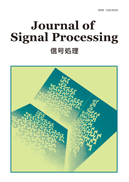
- 6 号 p. 229-
- 5 号 p. 207-
- 4 号 p. 133-
- 3 号 p. 81-
- 2 号 p. 41-
- 1 号 p. 1-
- |<
- <
- 1
- >
- >|
-
Reda Elbarougy, Bagus Tris Atmaja, Masato Akagi2020 年 24 巻 6 号 p. 229-235
発行日: 2020/11/01
公開日: 2020/11/01
ジャーナル フリーSpeech and visual information are the most dominant modalities for a human to perceive emotion. A method of recognizing human emotion from these modalities is proposed by utilizing feature selection and long short-term memory (LSTM) neural networks. A feature selection method based on support vector regression is used to select the relevant features among thousands of features extended from speech and video features via bag-of-X-words. The LSTM neural networks then are trained using a number of selected features and also separately optimized for every emotion dimension. Instead of utterance-level emotion recognition, time-frame-based processing is performed to enable continuous emotion recognition using a database labeled for each time frame. Experimental results reveal that a system with feature selection is more effective for predicting emotion dimensions for a single language than the baseline system without feature selection. The performance is measured in terms of the concordance correlation coefficient obtained by averaging the valence, arousal, and liking dimensions.
抄録全体を表示PDF形式でダウンロード (2818K) -
Masahiro Fukui, Suehiro Shimauchi, Akira Nakagawa2020 年 24 巻 6 号 p. 237-245
発行日: 2020/11/01
公開日: 2020/11/01
ジャーナル フリーThis paper attempts to estimate the residual echo spectrum that results from the reverberant component beyond a length of a short-time Fourier transform block. A residual echo reduction process suppresses a residual echo signal left after an adaptive filter eliminates an acoustic echo by applying a multiplicative gain calculated from an estimated residual echo power spectrum. However, the power-spectrum estimate in a conventional method reproduces only a fraction of the echo-path impulse response, and the remaining reverberant components are only estimated roughly. Therefore, the conventional method causes large estimation errors of the reverberant components. To address this problem, this paper proposes a finite nonnegative convolution method to estimate the residual echo power spectrum. This method first estimates the power spectra of each segment of echo-impulse response. The method then calculates the residual echo power spectra corresponding to each segment of the residual echo from the power spectra of each segment of the echo-impulse response. Finally, it obtains the residual echo power spectrum that includes the late reverberant components by convoluting their estimated power spectra in a time axis direction. The proposed method estimates all the power spectra in each segment of echo-impulse response by computing cross correlation between the complex spectra of the microphone-input and received speech signals, while shifting present and past frames of the received speech signal in the time axis direction.
抄録全体を表示PDF形式でダウンロード (1048K) -
22. Reconsideration of Maxwell Equation for Application of Quantum TheoryNobuo Nagai, Hirofumi Sanada, Takashi Yahagi2020 年 24 巻 6 号 p. 247-252
発行日: 2020/11/01
公開日: 2020/11/01
ジャーナル フリーCoils and capacitors are circuit elements that induce magnetic and electric fields, which are the fields of reactive power, when they are used independently. When multiple (n) LC ladder circuits are constructed using coils and capacitors and periodically connected, a transmission circuit that transmits active power is obtained. Because this circuit induces the phase kπ (k=1,2,…,n-1), the resonance angular frequency is obtained. Moreover, we examine a method of analytical mechanics for analyzing the Maxwell equations using a Hamiltonian, in which the path of light is examined considering refraction. The refraction of light waves means the generation of reflected waves, but the energy of the reflected waves is not considered in this method. Thus, it is shown that the analytical method does not satisfy the law of conservation of energy.
抄録全体を表示PDF形式でダウンロード (976K)
- |<
- <
- 1
- >
- >|